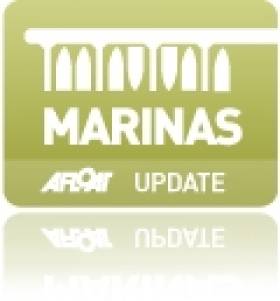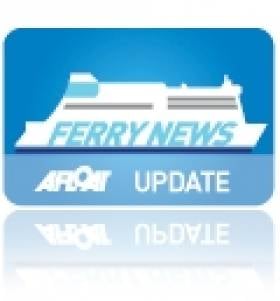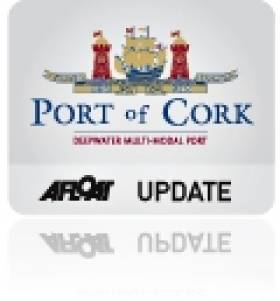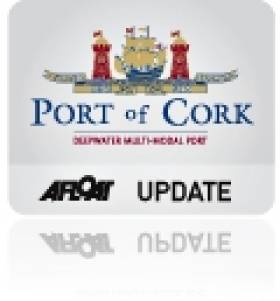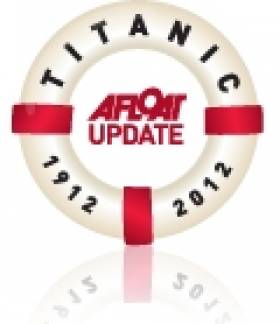Displaying items by tag: Cork Harbour
Marine Minister Officially Opens Cork Harbour Marina
An 88-berth Cork Harbour Marina located in Monkstown was officially opened on Saturday (7th of April) by Minister for the Marine, Simon Coveney, TD.
Phase one of the planned 300-berth marina facility in Monkstown Co. Cork, aptly named 'Cork Harbour Marina', is Ireland's newest coastal marina and is offering all year round berthing facilities for pleasure craft.
The new addition to the seaside village is in a sheltered location on the western bank of the River Lee in an area very popular for boating activities.
The bustling ceremony was also attended by Lord Mayor of Cork County, Michael McGrath of Fianna Fail, members of Monkstown Bay Sailing Club puls a number marine industry figures including John Wallace of Union Chandlery and Afloat.ie correspondent Tom MacSweeney.
As part of the proceedings the Irish Marine Federation's Steve Conlon saluted the tenacity of developer James O'Brien on completing the project. Steve Conlon's address gave a potted history to the new facility and we reproduce it here as an over view of the potential value of marinas to coastal communities:
I first met James some 8 years ago and I know how many hurdles he has crossed to get to this day, between planning, foreshore, State Valuation Office and the banks. These are just some of the impediments that are put in the way of would be developers who are putting in place valuable pieces of our tourism infrastructure. Marinas are sustainable developments, which will bring economic benefits to this area not only from resident boats but also from visitors.
From our own research we have established that the average spend per boat on a marina is in the region of €6,400 per annum. This is sum is made up of marina fees, insurance, training, sails, engine maintenance and chandlery spend.
An 88 berth marina, such as this one, has the potential to generate over €563,00.00. per annum in local economic activity. In addition our research shows that visiting boats spend on average almost €200 per night in the local community. Most of this money stays within the community. Our research also informs us that for every 2.7 marina berths, they support 1 full time job either in the marina itself or in associated business.
Stand alone marinas, like this one, are fine but they can become a real economic driver for an area when they begin to attract associated businesses into a Marine Industry Cluster of activity, such as boat sales, sailing and diving schools or bases for charter operations for deep sea angling and eco tours.
In terms of the marine leisure industry in Ireland it is worth in excess of €900 million per annum and accounts for 7% of our national tourism spend. Yet our national boat ownership ratio is low at 1 boat to every 156 people. Lots of room for expansion and development!
When you consider these figures and you realise what we have in terms of a natural resource on our doorstep, marina leisure tourism has the potential to deliver far more than it is in terms of international marine based visitors. We would like to see more incentives and promotional programmes put in place to encourage more overseas boat owners to base their boats in Ireland for at least two seasons to experience what we have on our South and West coast. To do this, however, we would need many more facilities such as this.
When you look at the global figures for marine activities, marine leisure tourism is the second most important economic activity after transport and shipping. It also accounts for 26% of the total global tourism product spend. The number one tourism product is cultural and heritage tourism at 27% of total global tourism. With our natural resources Ireland could become the marine leisure centre of excellence if it were to be developed in a sustainable way.
However, I am glad to say that attitudes are changing.
For the past 10 years the Irish Marine Federation has been calling for a National Integrated Marine Plan for Ireland, this request now seems to on the way to be answered.
There is one other person here to day I wish to thank and that is Minister Coveney. While he was in opposition he worked continually to promote the marine even when he did not have the portfolio.
We were delighted to see that he managed to incorporate Marine into his Ministerial title.
Through our involvement in ITIC, the Irish Tourist Industry Confederation I happened to meet Leo Varadka on the day that he was appointed as Minister of Transport, Tourism and Sport and I asked him if I could come to see him regarding marine leisure tourism, his reply was, yes, certainly but Simon Coveney is going to do something in that area.
I also know from my ongoing contacts with Failte Ireland that both the Minister Coveney and Minister Varadka met with Failte Ireland to discuss progress on the development of a marine leisure tourism strategy.
So on behalf of the marine industry in Ireland we would today like to congratulate both James O'Brien on the official opening of his marina and look forward to future developments on this site and also Minister Coveney for his work in promoting the marine industry in Ireland.
Berth bookings now being taken on 087 3669009.
Cork Boat Jumble 'Postponed'
#JUMBLE – A Boat Jumble in Cork city planned for this weekend at Custom House Quay has been 'postponed' following organiser concerns about a 'low level of participation'. The plan is to tweak the event format to encourage a greater take up and 'reschedule for a new date' according to a Boat Jumble spokesman.
Round the World Sailors Celebrate Cork Victory in the Caribbean
#OYSTER – A Cork yacht has taken a class win in the prestigious Oyster Regatta in the British Virgin Islands. Stephen and Aileen Hyde's Oyster 56 from Crosshaven, A Lady did not win a single race but their consistent form produced the best set of results from the Oyster Deck Saloon Division to secure victory for the Irish Team. The A Lady team is all from Ireland and they took great delight in accepting the winner's trophy and also the accolade of becoming one of the many Oysters that have circumnavigated the world's oceans. "In a single word, this regatta has been excellent." said Stephen Hyde. "I have to say that sailing 45,000 miles has been good practice for the event but winning isn't everything, there are so many good people at Oyster Regattas, I thought that the last Caribbean regatta was a great occasion and this one has certainly at least matched it. I have now sailed the world but I can say that there are few places as delightful to sail as the BVI, especially at an Oyster Regatta, it has been a memorable occasion."
Perhaps, David Tydeman, CEO of Oyster Marine summed up the Oyster's Regatta BVI at the final prize giving. "This has been one of the most friendly and enjoyable regattas of the 28 events we have had over the years. The sailing conditions have been nothing short of superb and the feedback coming from the Oyster owners is unanimous; the racecourses have provided a blend of amazing scenery and challenging sailing with close competition between the fleet. It had been especially pleasant to see nine Oysters in attendance for the first time and we hope that the experience will make them regular visitors to Oyster events."
For the last day of racing, sponsored by Pantaenius, The Oyster fleet enjoyed a passage race to Nanny Cay Marina. However, light winds necessitated a shorter course. Starting in the North Sound, a route around The Dogs then passed the western shore of Virgin Gorda, Fallen Jerusalem and Ginger Island where a finish line was laid. These islands offer mesmerising vistas of extraordinary beauty but also tactically challenging wind shifts and current eddies.
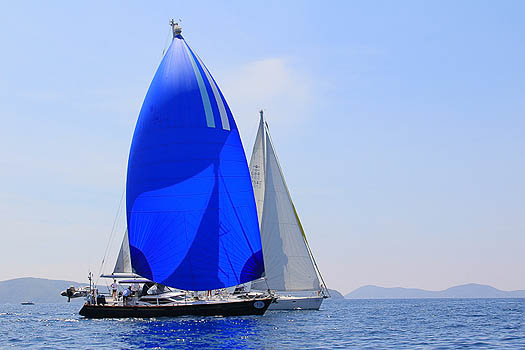
'Royal Cork's A Lady' under spinnaker and on her way to victory in the Oyster regatta yesterday
In Class 1, William Dockser's Oyster 82, Ravenous II timed the line to perfection, however this was a very competitive start especially between Chase Leavitt's Oyster 72, Holo Kai and Oyster 82, Starry Night of the Caribbean. The two powerful yachts were side by side through the line, just a few metres apart. Holo Kai managed to squeeze out Starry Night of the Caribbean and took up the early lead in the race. Chris and Susan Shea's Oyster 72, Magrathea chose to stay further to the right of the course after the start and it looked like a good choice. The graceful Oyster had better boat speed than those fighting for air in the wind shadow of The Dogs. Starry Night of the Caribbean managed to get into clear air first and powered away to win by some margin. Magrathea and Ravenous II had a tremendous battle for second place and not just for the race but also for runner up overall. Both yachts crossed the finish line together to score the same finish time. It had been a fascinating duel lasting over two hours. However, after time correction Magrathea claimed second in class with Ravenous II third.
Taking a hatrick of wins, Starry Night of the Caribbean was declared winner of Class 1, their crew boss John Burnie explained his thoughts. "It is just such a fabulous place to come for a regatta and I have to say that the courses have been excellent, hats off to Oyster, the event has really put a smile on Starry Night's crew and of course our owner, his family and guests. It is very satisfying to win but these regattas are all about enjoyment and I can safely say that we have had immense fun racing around the BVI."
In Class 1, a special mention must go to the two Oyster 655s; Michael Jones' Blue Horizons and John Noble's Neki, which came fourth and fifth respectively. Blue Horizons was competing in just their second regatta and Neki their first and both yachts scored the same number of nett points. However, Blue Horizons won the duel by virtue of a better result, (only one place!) in the last race. Also in Class 1, two Oyster 66s, Valentine and Forever Young had a tremendous battle for the line, the two yachts both had young children on board that had become friends during the regatta. Forever Young crossed the line first but Valentine won the match after time correction.
In Class 2, Ross Applebey's LW48, Scarlet Oyster was again untouchable, scoring their fourth win in a row by some distance. Ross is the youngest owner at the regatta but his team's performance showed great maturity and the extensive amount of racing experience was a big factor in their victory. "This is the first Oyster Regatta that we have competed in and I must say that the friendliness and hospitality has been fantastic." Explained Ross Applebey. "I was especially delighted that David Tydeman was on our table for the final dinner party but also the warm words of congratulation from Oyster owners has shown me the spirit of Oyster is first class. A very big thank you to everyone who has been racing and of course the Oyster team, this regatta has been a very special one for Scarlet Oyster."
Second place in the division went to Richard & Angela Parkinson's Oyster 575, Sophistikate, which finished the regatta in fine style winning the battle of the deck saloons, taking the last race of the event by over three minutes on corrected time and securing second overall, in a highly competitive class.
Three yachts had the same nett points after four races but Sopistikate was declared second by virtue of their final result. John McTigue's Oyster 56, Blue Dreams was third ahead of Bill Munro's Oyster 575, Boarding Pass III. Unfortunately the Scottish team on Boarding Pass III could not compete in the final race, a spinnaker wrap had damaged their main sail mechanism but every cloud has a silver lining, as Bill Munro explains;
"It was difficult to watch the fleet leave this morning but I was pleased to hear from Paul Bateman (Oyster 56, Stardust of Burnham) later in the day. I think that Paul showed the true spirit of Oyster when he offered me a replacement for the broken part, which he had as a spare. We meet other Oyster owners on our travels and we always try to help each other and Paul's kindness is a marvellous example of that."
On the final night of Oyster Regatta BVI, a prize giving party was held at Peg Legs Restaurant at Nanny Cay. Set right on the beach, under a carpet of stars, their was wave after wave of applause as the prize winners were announced. Oyster Owners and their crew take enormous pride in meticulously preparing and maintaining their yachts, ably assisted by the Oyster team who offer unparalleled worldwide support. Probably one of the biggest cheers of the night was for the winners of the Concours d'Elegance. Sponsored by Pelagos Yachts, Declan O'Sullivan was on hand to give out the prizes and the winners in Class 1 were Merle Gilmore's Oyster 66, Lady Tara and Michael Jones & Georgina Godolphin's Oyster 655, Blue Horizons. In Class 2, George & Sam Chandler's Oyster 56, Champlain and Richard & Angela Parkinson's Oyster 575, Sophistikate were awarded prizes for their immaculate yachts
After the prize giving ceremony, 200 guests enjoyed a sumptuous formal dinner and there were smiles all round, The Oyster family had enjoyed excellent sailing conditions, amazing scenery and a fabulous extravaganza of parties at some of the BVIs finest locations.
Owner of Oyster 72, Holo Kai, Chase Leavitt has come along way to compete, Manhattan Beach California is over 3,500 miles from the BVI. Chase summed up the spirit of the regatta.
"We have had a great time, we didn't come here to win, we came to have some fun with good friends and we definitely achieved that. I think our best manoeuvre of the week was after the finish, we anchored off Cooper Island had some cheeseburgers and went swimming, which I have got to say was a tactical masterstroke! Thank you to all the Holo Kai team. The name means seafarer in Hawaiian and comes from a place that myself and my wife Marla hold dear but we are regular visitors to the BVI, we love the atmosphere and the variety of islands so close together makes it an very interesting pace to visit."
The next Oyster Regatta will be a truly special event, hosted by the Royal Yacht Squadron from 9-14 July in Cowes to celebrate the Olympic year. Followed by t he Oyster fleet returns to Palma at the end of the summer, when many of the yachts on the Oyster World Rally will be gathering to make their way across to the Caribbean for the start of that event in Antigua on 6 January 2013.
Brittany Ferries 'Flagship' Sets Sail for Summer Season
#FERRY TO FRANCE – Brittany Ferries flagship Cork-Roscoff route is underway, as the first sailing in 2012 of the seasonal-only operated service started last weekend and runs to early November. Serving on the 14 hour route which is the shortest sailing to France, is the luxurious flagship Pont-Aven, writes Jehan Ashmore.
The 2,400 passenger /650 vehicle capacity Pont-Aven is unique to Irish services as she features a swimming pool. The indoor facility located on the top deck, includes a leisure area and pool bar which is open during the summer season and on busy off-season crossings.
In addition there are restaurants, a piano bar, main lounge, café and shop facilities. She has a wide choice of cabin accommodation that includes 'Commodore' cabins complete with balconies. For details about sailing schedules click HERE.
Roscoff is set in picturesque surroundings on the north-west Breton coast and the ferryport is a short distance even by foot to the town which has restaurants facing the coast. There is a botanical garden and a century-old thalassotherapy that has seawater and seaweed treatments used for healing and relaxation therapies.
More Cruise Liner Success for Port of Cork
The Port of Cork has scooped another two cruise awards for 2011. The awards for 'Best Shore side Welcome' and 'Best Tour Guides' were announced at Seatrade Miami, the global annual cruise shipping conference. This is the second year in a row that the Port has won such prestigious awards for their cruise business.
This announcement comes as the Port of Cork prepares to start their 2012 cruise season next week with the arrival of MV Balmoral and MV Marco Polo. In total up to 60 cruise liners will visit the port between April and November bringing over 100,000 passengers and crew to the region.
Receiving these awards, Chairman of the Port of Cork Mr Dermot O'Mahoney said: 'Receiving these global cruise awards shows the dedication and efforts made by the Port of Cork to ensure new and existing cruise companies continue to call to Cork. As well as investing in cruise facilities, the Port is also proactive in marketing the port and the region directly to the cruise companies.'
The winners of 'Cruise Insight' Annual Awards (formerly Dream World Cruise Awards) are based on surveys that are collected and analysed from Cruise Line Executives from all of the major cruise companies. The awards, launched in 1993, announce the ports and destinations that have provided outstanding services to ships, passengers and crew. The geographical mix of large and small ports receiving awards from Dubai, Far East, the Caribbean, Mediterranean, Baltic and Americas, reflected the global nature of the business. In 2011 there were a total of 87 worldwide winners, with 22 receiving more than one award, such as the Port of Cork.
Brendan Keating, Chief Executive of the Port of Cork also commented on the cruise awards saying: 'We as a port are very satisfied to have received these cruise awards two years in a row and we hope to continue our success next year. 2012 will be a another busy year for the cruise business in Cork, with 60 liners calling, of which three are operating part turnaround calls and ten liners are maiden visits to the port.'
He continued: 'While the port puts in a huge effort to bring the liners to Cork, the business would not work without the relationship and continued joint efforts of the Tour operators, Ship agents, Bus companies, Irish rail, local tourism groups and Cobh & Harbour Chamber, as well as the great tourist attractions on offer within the region, to help make the cruise business what it is today in Cork.
'2012 will also mark the 100th anniversary of the sinking of RMS Titanic which will attract many visitors to the town of Cobh. Both MV Balmoral and MV Marco Polo are carrying out themed Titanic cruises next week to commemorate the anniversary and Titanic 100 will also host a number of exciting events throughout the month in Cobh town.'
The Port of Cork is home to Ireland's only dedicated cruise berth in Cobh
'Boat Jumble’ Comes to Port of Cork
On Sunday 15th April from 10am to 4pm, the Port of Cork will host a Boat Jumble on Custom House Quay. The Boat Jumble, which comes to Cork for the first time, is an open air market for the sale of boating, sailing and water sports equipment and accessories, both old and new. Second hand boats/dinghies, sails, engines and nautical "car boot" items will also be on sale.
The Boat Jumble format has a proven appeal for trade and "car boot" participants as a low cost way of reaching a high footfall of people interested in marine products and services. The Boat Jumble offers value, bargains and of course the unusual.
To sell at the Boat Jumble (trade pitch or "car boot") pre booking is essential and restricted to marine related products and services. The booking form is on www.portofcork.ie and must be completed before the day, in order to secure your place.
As well as buying and selling, the Boat Jumble will also have catering on site and some light entertainment during the day. The RNLI will have a presence on the day and will provide a free check on Personal Flotation Devices (PFD). This is an important service to the boating public as the season commences.
The Boat Jumble is a great day for the boating public to find a bargain or that unusual kit suitable for your boat.
For visitors hunting for bargains on the day, admission is €5 and supervised children are free. Due to the restriction of space there will be no on site casual car parking available, however there are city car parks available close by.
Dream Home at Water's Edge on Great Island
#WATERFRONT PROPERTY - A beautifully restored period house on 14 acres of Great Island in Co Cork could be a dream home for any big spender.
Accepting offers over €3 million, the house at East Grove believed to date from the early 19th century and is constructed of stone under a slate roof, with attractive shallow gables.
Approached via a long wooded avenue, the house commands a magnificent position overlooking a peaceful inlet of Cork Harbour.
Accommodation comprises five reception rooms, including a drawing room, dining room and library; six bedrooms including a master bedroom with ensuite; and a fully fitted kitchen with black granite countertops and pantry.
Outside there is a courtyard with stables, a work shop and storerooms, as well as a one-bedroom apartment arranged on two floors, while further accommodation is available in the two-bedroom gate lodge with its own gardens.
Other amenities include a delightful walled garden, an indoor swimming pool, tennis courts and a boathouse with private harbour and boat slipway with a floating yacht pontoon and moorings.
Viewing of East Grove is strictly by appointment only with joint agents Knight Frank and Dominic Daly. More on the property is available HERE.
Photo Exhibition Includes Cobh’s ‘Titanic’ Pier
#PHOTO EXHIBITION -'The Pier' a collection of images created by French photographer Charlie Jouvet was launched this evening at Alliance Francaise, Dublin and continues into next month, writes Jehan Ashmore.
The images portrayed capture a meditative journey from the centre of the island of Cobh to the sea and features the town's former White Star Line pier. It is from this pier that liner tenders took the last passengers to board the R.M.S. Titanic which was anchored offshore.
Jouvet created the images while in residency with the Sirius Arts Centre in Cobh where there have been calls to preserve the historic 19th century pier also known locally as the 'Heartbreak' Pier as many emigrants departed Ireland for the last time and to seek new lives abroad.
Constructed of timber, the pier is in a perilous condition and according to experts could collapse unless urgent funding is found, as previously reported on Afloat.ie
The Berlin-based photographer has exhibited in his native France and also in Cambodia, Germany, Poland and Switzerland. His most recent work was at the PhotoPhnomPenh Festival which was held last November.
The Dublin exhibition continues to 21st April and is open to the public (free of charge) at Alliance Française, 1 Kildare Street, Dublin 2. For further information Tel: (01) 676 1732 and opening hours visit www.alliance-francaise.ie/gallery/
Cobh’s ‘Titanic’ Pier Could Collapse
#TITANIC- In the centenary year of commemorating the R.M.S. Titanic, the pier from where her last passengers boarded at Cobh (Queenstown) is in danger of collapsing unless funding is made available to carry out immediate preservation reports The Irish Times.
The 19th century pier constructed of timber is one of the most tangible links between the town and the liner which anchored offshore and where passengers boarded by tenders.
In addition many emigrants also trundled the pier's planks to depart Irish shores for the final time on ocean-going journeys to the four corners of the world in an effort to start new lives.
To read more about the story click HERE.
'Troika' Skipper Visits Cork
#ROWING – Debra Searle MBE, Atlantic rower and motivational speaker addresses Cork business people today. Searle defied the odds and the critics when she rowed single-handedly across the Atlantic in her boat The Troika. She is to deliver a major motivational talk to business owners as part of the Cork City and South Enterprise Boards' NEW Business Network on February 29th in the Rochestown Park Hotel.
When Debra's rowing partner left her alone at sea less than two weeks into a transatlantic rowing race, the sceptics gave her little chance of surviving the harsh conditions, loneliness and physical toll that faced her. The odds were stacked against her: most people would have seen the obstacles and adversity that loomed and would have quit. Yet in one of the World's most inspiring adventures, Debra faced down those obstacles and 111 days later she rowed into Port St Charles, Barbados, to a rapturous welcome from friends, family, supporters and the world's media
Debra will share this experience with Cork business people on February 29th. This event is an absolute must for every business person who is trying to keep positive and overcome obstacles in 2012 and beyond, as Debra will share powerful tools and techniques that she used to survive and keep on going in her journey alone, that we can use in our everyday and business lives. Debra Searle is not just a woman with an amazing story to tell. She is also an accomplished business woman having started her first company aged 24 and her second aged 27. She is a managing director, the youngest Trustee of The Duke of Edinburgh's Award, a published author and has presented over 40 programmes for the BBC.
Debra's overwhelming positivity and 'go for it' attitude are contagious. Through her own experiences she has helped numerous businesses, both large and small, to choose the right attitude, however impossible the end goal may seem. She has worked with organisations including IBM, Ford Motor Co., Microsoft, KPMG and England Rugby to get them to successfully step outside their comfort zone and thrive; find the positives when everything is changing; focus only that which can be changed; and stay motivated and determined, even when the journey only seems to be getting harder.
Debra Searle's lessons can help anyone to re-focus their efforts and overcome seemingly insurmountable obstacles. As Alan Farnsworth, President, Bausch & Lomb EMEA said of one of Debra's lectures, "I have never heard a better speech, anywhere, in any context ... People are still talking about it."
Sponsored by Cork City and South Cork Enterprise Boards and QED Training, Debra Searle will be speaking at the NEW Network in the Rochestown Park Hotel on Wednesday 29th February 2012 (Arrival and Networking from 6pm)
To register for the event go to (http://conta.cc/DebraSearleCork) or call Joanne on 0872882688. Members of the NEW network can attend this event as part of their annual membership. Non-members must register and the event fee of € 25 will apply.
All businesswomen in Cork are invited to become members of the Network of Enterprising Women (N.E.W.) NEW is organized jointly by Cork City and South Cork Enterprise Boards to provide a business-focused network for women. Members meet for four networking events per year, and the Network offers businesswomen a positive opportunity to make effective business contacts, develop new ideas and to be motivated by fellow members and speakers at networking events. Members also have the opportunity to promote their products and services through the network. Annual membership is €60 and new members should register for the network on www.sceb.ie or call 021 4975281 / 021 4961828.


























